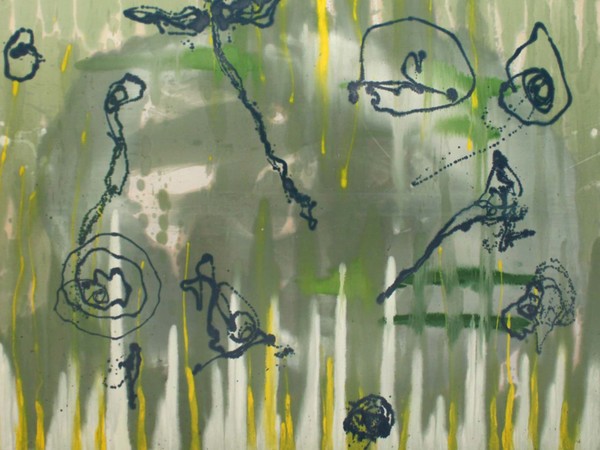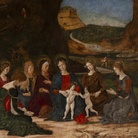Xanadu

Nikunja, Evolution by Matter, 2011, Mauritius
From 06 Maggio 2015 to 22 Novembre 2015
Venice
Place: Istituto Santa Maria della Pietà
Address: Castello 3701, Calle della Pietà
Times: Every day from 10am to 6pm. Mondays closed
Responsibles: Jamain Brigitha
Organizers:
- Dream Amsterdam Foundation
Official site: http://nikunja.org
Collateral Event of the 56th International Art Exhibition - la Biennale di Venezia
Dream Amsterdam Foundation (the Netherlands) proudly presents the commission of interdisciplinary artist Nikunja (Switzerland / Reunion Island, France) for his exhibition of the ongoing and evolving project XANADU, which premiers as a Collateral Event of the Biennale Arte 2015. Okwui Enwezor, curator of the 56th International Art Exhibition, selected the project within the frame of ‘All the World’s Futures’. XANADU refers to the ancient summer palace of Kublai Khan in Shangdu, which was built in 1251 exactly according to the dream of the Chinese emperor. Like the ancient dream temples, XANADU gathers the energies and experiences of its visitors specific to each place and time the work is shown. Jamain Brigitha, founding director and curator of Dream Amsterdam Foundation, curated Nikunja’s exhibition at Istituto Santa Maria della Pietà.
OPEN-ENDED POETRY
Since the early 1990s, Nikunja has put at the centre of his work the progressive energy of the artistic process. Every individual visitor will add and contribute to the content of XANADU. This approach engages the audience in a form of open-ended poetry, similar to dreams.
SPECTATOR AND PERFORMER
The worldwide premiere of XANADU consists of drawings, paintings, photos, videos and an interactive, multimedia installation. When visitors enter the exhibition, they are spectators, but they also become part of the artwork as performers. On special dates, the artist will be present to create new works of art in interaction with the individual visitors.
MÉTISSAGE
Nikunja did his research and created the works for XANADU between 2011 and 2015 in Europe (including Venice), Mauritius and Reunion Island, where he started working at the end of the 1990s. Réunion (whose French name signifies an act and not a place) is an exceptional island that successfully unites cultural and social extremes. Established circa 350 years ago, the fairly young post-colonial island society is signified by historical crime and reconciliation, but also by a long-established multiculturalism and tolerance. Reunionese culture is a ‘métissage’: a blend of European, African, Indian, Chinese, and insular traditions. It is a country with great diversity, where physical and spiritual energies, sorrows and dreams, as well as history and legends, rooted in major world cultures and religions all merge into a peaceful coexistence. In a time where most of the world seems to be struggling to accept “the other” as equal, the people in this society live in harmony, even in the midst of the colossal extremes of an unstable volcanic landscape. Nikunja incorporates these significant aspects of hybridisation in his artwork as formal principles and psychological references to social and individual states.
WHAT LIES IN-BETWEEN IS VALUABLE
Nikunja’s work is in a constant flux of adaptation, mutation and transformation. The artist explores and values the nomadic, unknown intermedial space between existing media. He searches for hybrid beings or the “ultimate bastard” in the creation of his artworks. He is in continuous discovery of the in-between spaces where other elements may be born. “The condition of transgression and mutation fits perfectly well with the spirit of our current age: globalization, migration, transculturalism, the end of grand narratives, the fading of traditional values, and the steep rise of individualism. The dynamic postmodern plurality of contemporary society goes hand-in-hand with a fast-evolving diversity in contemporary art.”
COLLECTIVE MEMORY AND UNIVERSAL KNOWLEDGE
For his installation, Nikunja creates intense cinematographic material of landscapes composed through the unique light, colours and sounds of Reunion Island in collaboration with cinematographer and photographer Jean Marc Selva (France), electronic musician Alain Perret (Switzerland) and sound engineer Benoît Saillet (Switzerland). The camera follows performer Mannee (Mauritius) through a variation of mental states. However, she is not a representation of a character or a role. XANADU is based on an open narrative structure and (partly) on dreams she has experienced. These dreams largely transcend any links to personal or present-day life; they go beyond these associations and instead make connections between individual and collective memory and universal knowledge. Nikunja collaborated closely with Mannee, who was born into a Mauritian family of Indian origin with a long tradition of spiritual and shamanic practices. She explains, “The ancestral land where I was living became the platform for much agony for what it was trying to convey to me: stories of lifetimes of slavery, torture, mass killings, coming from this soil of slavery. All telling me about the ‘lived’, the memories of ‘human criminology’ contained in specific places. To me it felt like the containment of the element of crime in the bowels of the earth.”
THE DREAM AS CREATIVE ENERGY
Nikunja acknowledges the dream as a form of creative energy. He describes dreaming as a nomadic, cultural and spiritual language that belongs to everyone, regardless of age, education, ethnicity, religion or social status. XANADU interrogates the intuitive, associative world of the dream and the creative potential of the dreamer, as well as the subjective division between the perception of reality and the various levels of dream perception. Nikunja states, “Dreams allow us to break with the patterns of day-to-day perception and convey a vaster reality of ourselves. The artificial separations in our mind disappear. Dreams connect us to the multi-layered reality of space and time. Dreams are reality. What we call awake could very well be asleep. Right now: are you dreaming or are you awake?”
Dream Amsterdam Foundation (the Netherlands) proudly presents the commission of interdisciplinary artist Nikunja (Switzerland / Reunion Island, France) for his exhibition of the ongoing and evolving project XANADU, which premiers as a Collateral Event of the Biennale Arte 2015. Okwui Enwezor, curator of the 56th International Art Exhibition, selected the project within the frame of ‘All the World’s Futures’. XANADU refers to the ancient summer palace of Kublai Khan in Shangdu, which was built in 1251 exactly according to the dream of the Chinese emperor. Like the ancient dream temples, XANADU gathers the energies and experiences of its visitors specific to each place and time the work is shown. Jamain Brigitha, founding director and curator of Dream Amsterdam Foundation, curated Nikunja’s exhibition at Istituto Santa Maria della Pietà.
OPEN-ENDED POETRY
Since the early 1990s, Nikunja has put at the centre of his work the progressive energy of the artistic process. Every individual visitor will add and contribute to the content of XANADU. This approach engages the audience in a form of open-ended poetry, similar to dreams.
SPECTATOR AND PERFORMER
The worldwide premiere of XANADU consists of drawings, paintings, photos, videos and an interactive, multimedia installation. When visitors enter the exhibition, they are spectators, but they also become part of the artwork as performers. On special dates, the artist will be present to create new works of art in interaction with the individual visitors.
MÉTISSAGE
Nikunja did his research and created the works for XANADU between 2011 and 2015 in Europe (including Venice), Mauritius and Reunion Island, where he started working at the end of the 1990s. Réunion (whose French name signifies an act and not a place) is an exceptional island that successfully unites cultural and social extremes. Established circa 350 years ago, the fairly young post-colonial island society is signified by historical crime and reconciliation, but also by a long-established multiculturalism and tolerance. Reunionese culture is a ‘métissage’: a blend of European, African, Indian, Chinese, and insular traditions. It is a country with great diversity, where physical and spiritual energies, sorrows and dreams, as well as history and legends, rooted in major world cultures and religions all merge into a peaceful coexistence. In a time where most of the world seems to be struggling to accept “the other” as equal, the people in this society live in harmony, even in the midst of the colossal extremes of an unstable volcanic landscape. Nikunja incorporates these significant aspects of hybridisation in his artwork as formal principles and psychological references to social and individual states.
WHAT LIES IN-BETWEEN IS VALUABLE
Nikunja’s work is in a constant flux of adaptation, mutation and transformation. The artist explores and values the nomadic, unknown intermedial space between existing media. He searches for hybrid beings or the “ultimate bastard” in the creation of his artworks. He is in continuous discovery of the in-between spaces where other elements may be born. “The condition of transgression and mutation fits perfectly well with the spirit of our current age: globalization, migration, transculturalism, the end of grand narratives, the fading of traditional values, and the steep rise of individualism. The dynamic postmodern plurality of contemporary society goes hand-in-hand with a fast-evolving diversity in contemporary art.”
COLLECTIVE MEMORY AND UNIVERSAL KNOWLEDGE
For his installation, Nikunja creates intense cinematographic material of landscapes composed through the unique light, colours and sounds of Reunion Island in collaboration with cinematographer and photographer Jean Marc Selva (France), electronic musician Alain Perret (Switzerland) and sound engineer Benoît Saillet (Switzerland). The camera follows performer Mannee (Mauritius) through a variation of mental states. However, she is not a representation of a character or a role. XANADU is based on an open narrative structure and (partly) on dreams she has experienced. These dreams largely transcend any links to personal or present-day life; they go beyond these associations and instead make connections between individual and collective memory and universal knowledge. Nikunja collaborated closely with Mannee, who was born into a Mauritian family of Indian origin with a long tradition of spiritual and shamanic practices. She explains, “The ancestral land where I was living became the platform for much agony for what it was trying to convey to me: stories of lifetimes of slavery, torture, mass killings, coming from this soil of slavery. All telling me about the ‘lived’, the memories of ‘human criminology’ contained in specific places. To me it felt like the containment of the element of crime in the bowels of the earth.”
THE DREAM AS CREATIVE ENERGY
Nikunja acknowledges the dream as a form of creative energy. He describes dreaming as a nomadic, cultural and spiritual language that belongs to everyone, regardless of age, education, ethnicity, religion or social status. XANADU interrogates the intuitive, associative world of the dream and the creative potential of the dreamer, as well as the subjective division between the perception of reality and the various levels of dream perception. Nikunja states, “Dreams allow us to break with the patterns of day-to-day perception and convey a vaster reality of ourselves. The artificial separations in our mind disappear. Dreams connect us to the multi-layered reality of space and time. Dreams are reality. What we call awake could very well be asleep. Right now: are you dreaming or are you awake?”
SCARICA IL COMUNICATO IN PDF
COMMENTI

-
 Dal 20 dicembre 2024 al 04 maggio 2025
Fermo | Palazzo dei Priori
Dal 20 dicembre 2024 al 04 maggio 2025
Fermo | Palazzo dei Priori
-
 Dal 20 dicembre 2024 al 04 maggio 2024
Gorizia | Palazzo Attems Petzenstein
Dal 20 dicembre 2024 al 04 maggio 2024
Gorizia | Palazzo Attems Petzenstein
-
 Dal 18 dicembre 2024 al 18 dicembre 2024
Venezia | Museo Correr
Dal 18 dicembre 2024 al 18 dicembre 2024
Venezia | Museo Correr
-
 Dal 14 dicembre 2024 al 02 marzo 2025
Palermo | Palazzo Abatellis
Dal 14 dicembre 2024 al 02 marzo 2025
Palermo | Palazzo Abatellis
-
 Dal 12 dicembre 2024 al 23 febbraio 2025
Roma | Palazzo Altemps
Dal 12 dicembre 2024 al 23 febbraio 2025
Roma | Palazzo Altemps
-
 Dal 13 dicembre 2024 al 31 agosto 2025
Roma | Museo dell'Ara Pacis
Dal 13 dicembre 2024 al 31 agosto 2025
Roma | Museo dell'Ara Pacis


